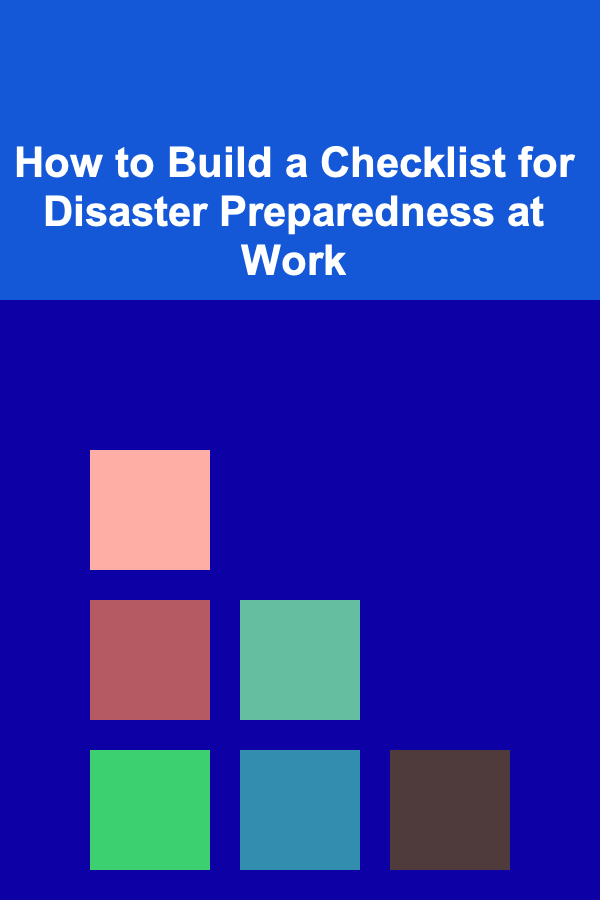
How to Build a Checklist for Disaster Preparedness at Work
ebook include PDF & Audio bundle (Micro Guide)
$12.99$11.99
Limited Time Offer! Order within the next:

Disasters, both natural and man-made, can strike at any time. When they do, businesses must be prepared to respond quickly and effectively to minimize harm to employees, property, and operations. A well-thought-out disaster preparedness plan can make all the difference between surviving a crisis and suffering long-term damage.
In this actionable guide, we'll walk you through the process of creating a comprehensive disaster preparedness checklist for your workplace. We'll cover the key components of disaster preparedness, including assessing risks, establishing emergency protocols, and ensuring your employees are trained and ready.
Step 1: Assess Potential Risks
The first step in disaster preparedness is understanding the specific risks your workplace may face. Disasters vary greatly depending on location, industry, and the type of business you run. While some disasters, such as earthquakes or hurricanes, may be more relevant to certain regions, others like power outages or fires can affect nearly any workplace.
Actionable Steps:
-
Identify Local Hazards: Start by reviewing the natural disasters or man-made crises that are most likely to impact your area. These could include:
- Natural Disasters: Earthquakes, floods, wildfires, hurricanes, tornadoes, or blizzards.
- Man-Made Disasters: Chemical spills, workplace violence, terrorist attacks, cyberattacks, or industrial accidents.
-
Review Past Incidents: Look at past events in your area or industry to determine what kind of emergencies have occurred and how your company responded. This can help highlight any gaps in your current preparedness strategy.
-
Assess Vulnerabilities in Your Workplace: Evaluate your physical space, equipment, and employees' roles. For example, a warehouse may be more prone to fire hazards, while an office building may be vulnerable to power outages. Consider the specific risks related to your operations.
Step 2: Develop an Emergency Response Plan
Once you have a solid understanding of the risks, you can begin building your emergency response plan. This plan should outline specific actions that need to be taken in case of a disaster to ensure employee safety and business continuity.
Actionable Steps:
-
Define Emergency Procedures: Outline clear, step-by-step procedures for various disaster scenarios. These procedures should be easy to follow and accessible to all employees. For example, your fire emergency procedures might include:
- Evacuation routes and assembly points.
- Roles for staff members (e.g., one person is responsible for calling emergency services).
- Procedures for using fire extinguishers, if applicable.
-
Establish Communication Protocols: Ensure that there are clear lines of communication both during and after the disaster. This includes:
- Internal Communication: A reliable method for alerting employees about the disaster (e.g., text messages, internal loudspeakers, or email).
- External Communication: Procedures for contacting emergency services, local authorities, and key stakeholders such as customers, suppliers, and clients.
-
Designate Emergency Roles: Identify specific roles for employees during a disaster. These may include:
- Evacuation Coordinators: Staff who ensure everyone evacuates safely.
- First Aid Responders: Employees trained in basic first aid and CPR.
- Communication Leads: Staff responsible for keeping the team informed during and after the event.
-
Create an Evacuation Plan: Detailed evacuation plans should include:
- Clearly marked exit routes and exits that are easily accessible.
- Instructions for people with disabilities or other special needs.
- Assembly points where employees can gather after evacuating.
Step 3: Establish Business Continuity Measures
Disasters can disrupt business operations, leading to financial losses, legal ramifications, and damaged reputations. To minimize downtime and maintain business continuity, you'll need a solid recovery plan.
Actionable Steps:
-
Data Backup and Protection: Ensure that all important business data is regularly backed up and stored securely. Consider using both on-site and off-site storage solutions, such as cloud storage, to ensure that critical information is protected in case of a disaster.
-
Alternate Work Locations: Establish alternate work locations if your primary office or facility becomes unusable. This could involve:
- Remote work setups for employees.
- Pre-arranged agreements with nearby office spaces that can be used temporarily.
-
Supply Chain Continuity: Identify critical suppliers and ensure that there are backup options available in case your usual suppliers are affected by the disaster. This could involve:
- Diversifying suppliers to avoid relying on a single source.
- Creating contingency plans for quick procurement of essential goods.
-
Insurance Coverage: Ensure that your business has adequate insurance coverage to cover losses due to natural disasters, equipment failure, or other business disruptions. Work with an insurance professional to evaluate your needs.
Step 4: Train Your Employees
No disaster preparedness plan is effective without proper training for your employees. They need to know how to respond in a crisis to protect themselves and others. Regular training will ensure everyone is familiar with their roles and the emergency procedures.
Actionable Steps:
-
Conduct Regular Drills: Organize emergency drills to simulate different disaster scenarios. These could include fire drills, evacuation exercises, and even cyberattack simulations. Drills should be conducted at least once or twice a year, but more frequent drills may be necessary for high-risk businesses.
-
Train Employees on Safety Procedures: Provide training on first aid, CPR, fire safety, and other relevant safety procedures. Ensure that employees know how to use safety equipment like fire extinguishers and emergency medical kits.
-
Test Communication Channels: Regularly test your communication protocols to ensure they work effectively. This includes:
- Testing emergency notification systems.
- Ensuring all employees are familiar with how to access emergency alerts.
-
Ensure Special Needs Are Addressed: Train employees on how to support individuals with special needs or mobility challenges during an emergency, including those who may need additional assistance in evacuations.
Step 5: Create a Disaster Recovery Checklist
Once your emergency response plan is in place, create a checklist that can be easily referenced during a disaster. This checklist should cover all critical steps that need to be taken during and after a disaster.
Actionable Steps:
-
Create Actionable Steps: The checklist should include a list of tasks to be completed during a disaster. Some examples could include:
-
Before the Disaster:
- Ensure all emergency supplies (first aid kits, flashlights, etc.) are stocked.
- Confirm communication systems are operational.
- Review evacuation routes with employees.
-
During the Disaster:
- Activate emergency communication systems.
- Evacuate employees according to the established procedures.
- Contact emergency services.
-
After the Disaster:
- Assess employee safety and ensure everyone is accounted for.
- Begin business continuity actions (e.g., activating backup data systems).
- Communicate with customers and stakeholders.
-
-
Ensure Accessibility: Keep the disaster recovery checklist in a visible, easily accessible location. It could be a printed version posted in key areas (like break rooms and exit doors) and a digital version accessible through your company's intranet or communication platforms.
-
Review and Update Regularly: A disaster recovery checklist is a living document that should be reviewed and updated regularly, especially after drills or real-world emergencies. This ensures it reflects any changes in procedures, personnel, or workplace infrastructure.
Step 6: Build a Disaster Recovery Kit
A well-stocked disaster recovery kit can be invaluable when disaster strikes. These kits should contain essential items to help employees during a crisis, including first aid supplies, flashlights, and emergency food and water.
Actionable Steps:
-
Essential Supplies: Include the following in your disaster recovery kit:
- First aid supplies (bandages, antiseptics, pain relievers, etc.).
- Flashlights and extra batteries.
- Portable phone chargers.
- Water and non-perishable food items.
- Emergency contact numbers for key personnel.
-
Personal Protective Equipment: Depending on the nature of your business, you may also need to include personal protective equipment (PPE), such as face masks, gloves, or fire-resistant clothing.
-
Location of Kits: Ensure that disaster recovery kits are easily accessible in various parts of the workplace. For example, place kits near exit routes, in break rooms, and in areas with higher-risk activities.
Conclusion
Building a disaster preparedness checklist for your workplace is a critical part of ensuring the safety of your employees and the continuity of your business operations. By carefully assessing potential risks, developing a comprehensive emergency response plan, training employees, and creating a well-stocked disaster recovery kit, you'll be able to respond quickly and effectively in the event of a crisis.
Disaster preparedness is an ongoing process, not a one-time task. Regular drills, reviews of procedures, and updates to your checklist will keep your workplace ready for any disaster that may come its way. The more thorough and organized your disaster preparedness efforts, the better positioned your business will be to weather any storm---literally or figuratively.
Reading More From Our Other Websites
- [Home Family Activity 101] How to Plan a Multi-Day Family Treasure Hunt That Builds Anticipation and Teamwork
- [Home Space Saving 101] How to Maximize Space with Pocket Doors: A Guide to Unlocking Hidden Potential in Small Rooms
- [Home Budget Decorating 101] How to Update Your Home's Lighting Without Spending a Fortune
- [Whitewater Rafting Tip 101] Pioneers of the Rapids: Key Figures Who Shaped Whitewater Rafting History
- [Home Budget 101] How to Find Affordable Home Furniture Without Compromising Quality
- [Organization Tip 101] Step-by-Step Guide to Setting Up a Drip Irrigation System
- [Personal Care Tips 101] How to Shave with Shaving Cream for Soft, Smooth Skin All Day
- [Organization Tip 101] Why Labeling Your Storage is Essential
- [Home Cleaning 101] How to Clean and Disinfect High-Touch Surfaces Properly
- [Home Staging 101] How to Stage a Home for Virtual Tours and Online Listings

How to Create an Interview Preparation Checklist for First-Time Job Seekers
Read More
How to Organize a Family Baking Challenge
Read More
How To Paint Expressive Abstracts
Read More
How to Use Motion Detectors to Enhance Your Home Security
Read More
10 Tips for Marketing Your Handmade Gift Boxes Online
Read More
10 Tips for Feng Shuiing Your Entryway for Positive Energy
Read MoreOther Products

How to Create an Interview Preparation Checklist for First-Time Job Seekers
Read More
How to Organize a Family Baking Challenge
Read More
How To Paint Expressive Abstracts
Read More
How to Use Motion Detectors to Enhance Your Home Security
Read More
10 Tips for Marketing Your Handmade Gift Boxes Online
Read More